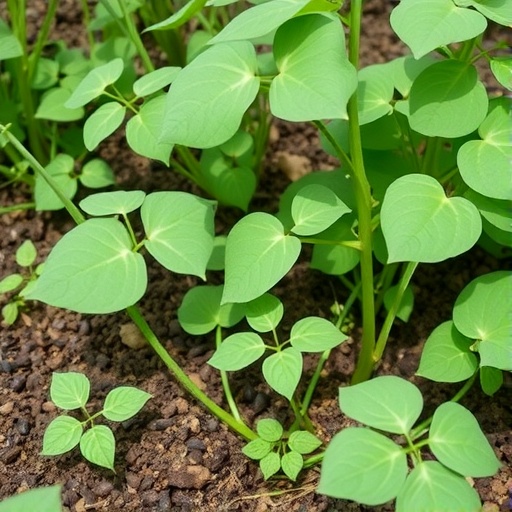Groundbreaking research has emerged in the field of plant molecular genetics, focusing on the dynamic defense mechanisms employed by cowpea plants when confronted with viral infections, specifically the Cowpea Aphid-borne Mosaic Virus (CABMV). In their recent study, de Andrade Luz and colleagues delve into the intricate world of transcriptome analysis, revealing significant insights into the role of phenylpropanoids and (iso)flavonoids in the defensive response of cowpea leaves following CABMV inoculation. This work bridges the gap between viral resistance mechanisms and practical applications in crop improvement and protection strategies.
The pressing need to enhance crop resilience in the face of ever-evolving viral threats is underscored by the economic importance of leguminous plants, particularly cowpeas, which are staple foods in many tropical and subtropical regions. The research highlights how understanding the biochemical pathways that become activated during viral attacks can provide valuable information for agronomic practices. The findings from de Andrade Luz et al. present a potential roadmap for breeding programs aimed at developing CABMV-resistant cowpea varieties.
At the molecular level, the study meticulously catalogs the transcriptome alterations occurring in cowpea leaves post-CABMV inoculation. This comprehensive analysis serves to identify and characterize the various genes associated with defensive responses, including those involved in the biosynthesis of phenylpropanoids and flavonoids, which are critical in mediating plant stress response. The authors report that these secondary metabolites play a crucial role in enhancing resistance against viral pathogens by reinforcing cell walls and possessing antioxidant properties.
Utilizing advanced genomic and transcriptomic technologies, the authors synthesized a vast array of data that illustrates the transcriptional shifts during the cowpea’s interaction with CABMV. Their findings reveal a temporal expression pattern of key genes involved in the phenylpropanoid pathway, suggesting a coordinated response mechanism that allows the plant to fine-tune its defense strategies. This temporal regulation is vital as it indicates potential windows for intervention or genetic manipulation to bolster defense mechanisms.
Interestingly, the research also emphasizes the cooperative role of various phytohormones in mediating defense responses. The study discusses how hormones such as jasmonic acid and salicylic acid are implicated in the regulatory networks that activate these protective measures. Specifically, the interplay between hormones and defense-related genes is a fascinating aspect that could inform biotechnological strategies aimed at enhancing plant immunity.
Moreover, the researchers employed both differential gene expression analysis and metabolic profiling to assess the functional relevance of the identified defense pathways. By integrating these approaches, they were able to elucidate not only which genes are induced but also how these genes translate into observable biochemical responses. Such integration is crucial for understanding the broader implications of these responses on plant health and yield.
Cowpea’s ecological adaptability to various environmental stresses is another layer that enhances the importance of this research. The study indicates that the insights garnered from analyzing the interplay between the plant’s defense mechanisms and CABMV can pave the way toward sustainable agricultural practices. By harnessing the genetic diversity embedded within cowpea populations, breeders can develop cultivars that not only resist pests and diseases but also thrive under suboptimal growing conditions.
The potential applications of this work extend beyond cowpeas alone, as the mechanisms of viral resistance elucidated here may find relevance across other crops subjected to similar pathogenic pressures. This cross-application of findings underscores the importance of research into plant defenses, especially amid global challenges such as climate change and food security.
Another interesting aspect discussed in the study is the potential for employing genomic editing techniques, such as CRISPR/Cas9, to directly target and enhance the defense genes associated with phenylpropanoid and flavonoid production. Such precise genetic modifications could lead to rapid advancements in crop resilience, allowing for the cultivation of varieties with inherently superior viral resistance.
As the narrative of the cowpea unfolds through this research, the authors caution against complacency in the face of crop diseases. They urge continued investment in research that foregrounds genetic diversity and ecological adaptability, advocating for interdisciplinary collaboration among molecular biologists, plant breeders, and environmental scientists. This collaborative spirit is essential for developing holistic solutions that address the multifaceted challenges of modern agriculture.
Importantly, the study advocates for a proactive approach to disease management, highlighting how understanding the basic biology of plant-pathogen interactions can inform integrated pest management strategies. The authors encourage stakeholders to transcend traditional agricultural paradigms by embodying the principles of genomic foresight and sustainable practices.
In conclusion, de Andrade Luz et al.’s research offers a compelling glimpse into the dynamic relationships between plants and their pathogenic adversaries. By unveiling the defensive pathways activated in cowpea leaves following CABMV inoculation, this study contributes significantly to the body of knowledge required for advancing agricultural resilience. As farmers and policymakers alike grapple with the implications of crop vulnerability, insights such as those provided in this study will prove invaluable in shaping the future of food security.
Subject of Research: Cowpea Defense Mechanisms Against CABMV
Article Title: Unveiling Dynamic Defense Pathways: Transcriptome Analysis of Phenylpropanoids and (Iso)flavonoids in Cowpea Leaves Post-CABMV Inoculation
Article References:
de Andrade Luz, G., da Costa Gomes, M.F., Ferreira-Neto, J.R.C. et al. Unveiling Dynamic Defense Pathways: Transcriptome Analysis of Phenylpropanoids and (Iso)flavonoids in Cowpea Leaves Post-CABMV Inoculation. Biochem Genet (2025). https://doi.org/10.1007/s10528-025-11286-x
Image Credits: AI Generated
DOI: https://doi.org/10.1007/s10528-025-11286-x
Keywords: Cowpea, CABMV, phenylpropanoids, (iso)flavonoids, molecular genetics, crop resilience, transcriptome analysis, plant defense mechanisms.




